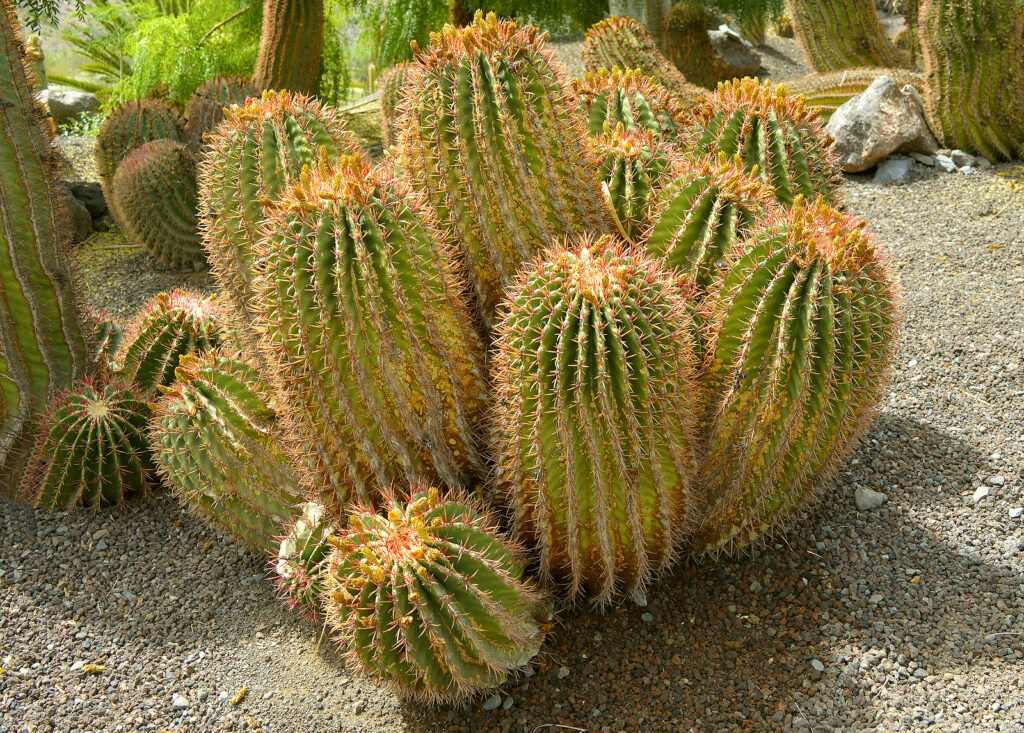Ferocactus–commonly called barrel cactus–is a genus of more than 30 species of cacti that are generally spherical when young, and later becomes columnar and grow to 13 feet (4m) tall. Ferocactus are noted for its colored spines which may be hooked or straight.
Ferocactus bears flowers at the crown of the plant. Flowers can be yellow to red, pink to purple Fleshym oblong fruit with tiny black seeds follow the flowers. Flowers appear on mature plants, at least 12 inches (30 cm) tall, in summer.
Ferocactus begin as spiny globes, then broaden and become heavily ribbed. They are heavily spined and should be planted away from paths or walkways.
Many Ferocactus species are frost resistant; most are able to withstand cool temperatures if kept completely dry.
Get to know Ferocactus
- Plant type: Cactus, barrel cactus
- Hardiness temperature: 30℉ (-1.1℃)
- Optimal growing temperature: prefers 65° to 90°F (18° to 32°C) range.
- Shape and size: Up to 10 feet tall and weighing hundreds of pounds
- Flowers: Solitary blooms at the top of their stems can be yellow, red, pink, or purple
- Bloom time: Spring, summer
- Common name: Barrel cactus
- Genus name: Ferocactus
- Family name: Cactaceae
- Origin: Southwest United States

Planting Ferocactus
- Plant Ferocactus in full sun.
- Indoor grow Ferocactus in bright light from southern exposure to enhance colored spines. Air circulation is important.
- Plant Ferocactus in well draine sandy loan or cactus mix.
- Plant Ferocactus away from heavily traveled areas; spine are long and sharp
How to water and feed Ferocactus
- Water Ferocactus regularly during the growin season, but the soil should not stay wet.
- Let soil dry between moderate waterings. Avoid overwatering. Humidity, 20% to 25%.
- Feed Ferocactus with a high-potassium fertilizer during the spring and summer growing season, not during dormancy.
Ferocactus care
- Check Ferocactus for aphids, mealybugs, spider mites, scale. Also be alert for fungus disease.
- Let Ferocactus rest during winter. Place Ferocactus in a cool place, 50°F (10°C). Water just enough to keep soil from drying out and withhold fertilizer.
- Ferrocactus can withstand cool temperatures if kept dry.
- Propagate Ferocactus by seed.
Ferocactus species to grow
- Ferocactus acanthodes (fire barrel). Cylindrical, columnar stems bear stout reddish spines; may grow to 36 inches (91 cm) tall; bright green stems feature pink to bright red, hooked spines; older plant can grow to 9 feet tall; bright yellow flowers appear at top of the stem on mature plants.
- F. covillel (fishhook cactus). Grows to 5 feet tall; reddish-white radial spines and solitary, hooked central spine; fishhook common name refers to vicious, central spine; 2-3 inch flowers are red to yellow.
- F. glaucesnens (blue barrel). Solitary stem is bluish green, spines are straight and pale yellow.
- F. hamatacanthus (turk’s head). Oblong stems grow to 3 feet tall; brown spines and yellow flowers often with red throats.
- F. latispinus (devil’s tongue cactus). Gray-green stems grows to 12 inches (30 cm); flat, hooked spines are yellow; central spines are red; a single spine may protrude from the center of the plant; rose-colored flowers are sweetly scented.
- F. rectispinus (hatpin cactus, giant spined barrel). Sharp spines up to 10 inches long; 3-inch-yellow flowers.
- F. setispinus (strawberry cactus). Foot-tall stems are spiraled, deeply tubercled; spines are yellow to brown with one prominently hooked; yellow flowers have red centers.
- F. wisiizenll (Arizona barrel). Columnar stems; bears white, needlelike radial spines with red, brown, or gray, hooked, central spines; bright yellow flowers, often marked with red at edges.















